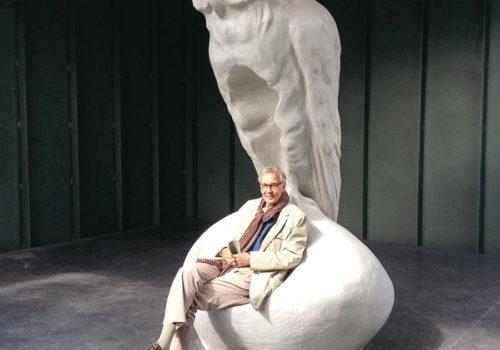We have just announced the release of Pierre Apraxine‘s Mémoires d’un collectionneur.
On June 26, 2011, we published a tribute to Pierre by Sylvie Aubenas, director of the photo department of the Bibliothèque Nationale.
Here it is:
Pierre Apraxine is today a reference for photography collectors. His reputation in the field grew towards the end of the 1970’s when, as an advisor to the American industrialist Howard Gilman (1924-1998), he persuaded Gilman to add an ambitious selection of photographs to his other art collections. This new collection grew over the years beyond their wildest imagination. Their collaboration would last more than 20 years, allowing it to grow into one of the most interesting private collections of historic and contemporary photographs of its time, one that was an icon. It was displayed in 1993 at the Metropolitan Museum of Art of New York under the title The Waking Dream. A selection of 40 prints that were also seen by the French public in 1998 at the Paris Photo fair. Since Howard Gilman’s death in 1998, Pierre Apraxine has been over seeing this unique collection as it made its transition into the Metropolitan Museum’s holdings.
He then began organizing particularly demanding exhibitions. He first worked on Roger Thérond’s exhibition at the Maison Européenne de la Photographie (MEP) in 1999, helping the collector and his curator Anne de Mondenard make their final choices for the exhibit now known as Une passion française. Later he worked with passionate determination on the exhibition devoted to the Countess de Castiglione held at the Metropolitan and at the Musée d’Orsay, 1999-2000. In 2004-2005, he organized an exhibition at the MEP and the Metropolitan about Photography and the Occult.
Initially a talented specialist in contemporary and modern art, Pierre Apraxine applied his visual arts skills onto photography during a time when specialists and published resources were rare. He could exercise freely the rare gift he possessed: he had an eye. Not an art historian’s eye like Bernard Berenson, which was nourished by documents and comparative images, allowing him to distinguish, what can be attributed to a master’s work in a painting and what was done by his apprentices. Rather, Apraxine has an “absolute eye,” similar to a musical ear. Early photographic collectors were offered such an immense selection at relatively modest prices, choosing pictures without weighing their estimated value or references was still possible. This method of selection was also employed by French gallery owners Hugues Autexier and François Braunschweig, creators of the mythical gallery Texbraun. One could rediscover great 19th century authors or reveal new ones through the trained eye of the late-twentieth century. This approach was opposite of the one illustrated at the same time by André and Marie-Thérèse Jammes, booksellers and learned photography collectors; who had a selection, in no way less pertinent.
The day I met Pierre Apraxine, 15 years ago, he was preparing his exhibition on the Countess Virginia de Castiglione. He was looking for large unique portraits of her painted on photographic prints. I had never met him; for me, he was just a researcher like any other who came to consult our collection. I answered his question by showing him the portrait of the Countess, dressed as the Queen of Hearts for a court ball at the time of Napoleon III. The picture was still in its original frame, with a stucco heart inscribed with her initial, “V.” Pierre Apraxine’s reaction was quite different from the interest and satisfaction shown by an enthusiastic University student discovering an important work. I had the impression of entering a strange universe, very different from the quiet and padded atmosphere of a print study room. We were suddenly in the jungle and I had produced the tiger to meet the hunter.
I finally understood what it meant for a true collector to discover a long desired image. A long walk through the jungle, hoping to confront a tiger around the bend – a tiger or any other animal, whose existence one could only dream about. I understood, thanks to him, that I was in charge of the jungle and that I could wander in it forever with a few fellow explorers of the same character. He also revealed to me that the most rewarding aspects of a collection as abundant, historic and unfathomable as ours; is to go hunting for the tiger in excellent company.
Conversations with Pierre Apraxine about his projects, whether about Castiglione, ghosts, or anything else, were always marvelous. This Proust specialist’s thoughts would stretch and volute like velvety clouds with soft edges; one didn’t always understand where he was heading or what he wanted, occasionally, one was worried for him… until suddenly the clouds would change into rain and lightning.
These conversations were often peppered with the realization that accidents didn’t just happen, that the moment when the tiger would make an appearance was deliberate and merited, and also that photography abolished time. Castiglione or Gustave Le Gray seemed so much more familiar and friendly than many of our contemporaries. We often asked ourselves what they might have thought of our projects.
Nevertheless, Pierre Apraxine is an impeccable, not to say implacable professional, like the great American curators and connoisseurs. This is an aspect of his personality that one can easily forget, when overwhelmed by his charm and the multiplicity of his interests. This professional side would suddenly burst out in a rapid precision, and the rigor of his choices. When he kindly helped to install the difficult Le Gray exhibition, I was enchanted to see him transform into foreman, assuming a decisive and efficient control without compromise.
Permit me to reveal a coincidence of our respective childhoods, his Russian and mine French, we both grew up in the same neighborhoods in Brussels, separated by only a few years. This I believe allowed us to share an instant sympathy, not unlike the one Felix Nadar deemed essential to make a portrait.
Sylvie Aubenas
















